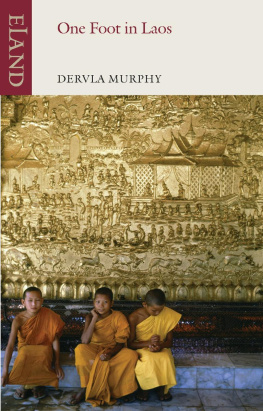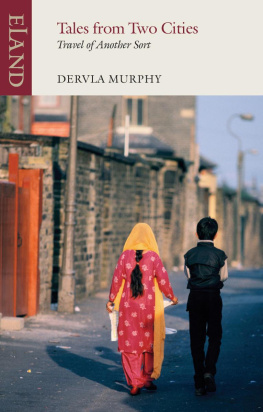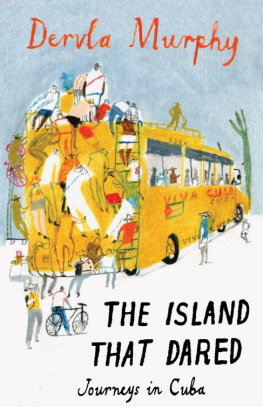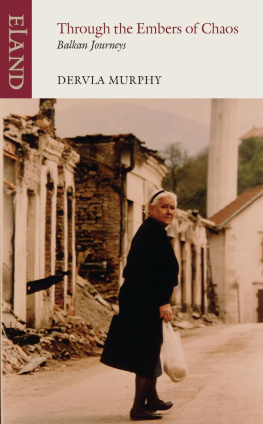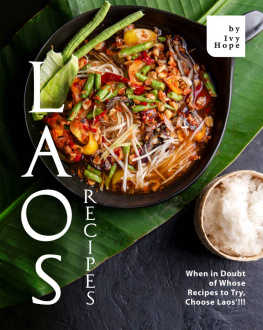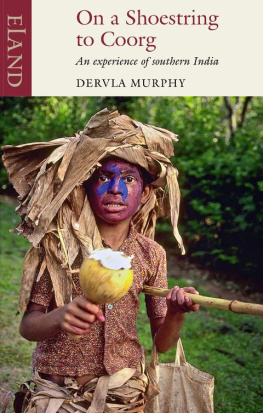Dervla Murphy - One Foot in Laos
Here you can read online Dervla Murphy - One Foot in Laos full text of the book (entire story) in english for free. Download pdf and epub, get meaning, cover and reviews about this ebook. year: 2017, publisher: Eland Publishing, genre: Detective and thriller. Description of the work, (preface) as well as reviews are available. Best literature library LitArk.com created for fans of good reading and offers a wide selection of genres:
Romance novel
Science fiction
Adventure
Detective
Science
History
Home and family
Prose
Art
Politics
Computer
Non-fiction
Religion
Business
Children
Humor
Choose a favorite category and find really read worthwhile books. Enjoy immersion in the world of imagination, feel the emotions of the characters or learn something new for yourself, make an fascinating discovery.
- Book:One Foot in Laos
- Author:
- Publisher:Eland Publishing
- Genre:
- Year:2017
- Rating:5 / 5
- Favourites:Add to favourites
- Your mark:
- 100
- 1
- 2
- 3
- 4
- 5
One Foot in Laos: summary, description and annotation
We offer to read an annotation, description, summary or preface (depends on what the author of the book "One Foot in Laos" wrote himself). If you haven't found the necessary information about the book — write in the comments, we will try to find it.
One Foot in Laos — read online for free the complete book (whole text) full work
Below is the text of the book, divided by pages. System saving the place of the last page read, allows you to conveniently read the book "One Foot in Laos" online for free, without having to search again every time where you left off. Put a bookmark, and you can go to the page where you finished reading at any time.
Font size:
Interval:
Bookmark:

For Caitriona, John and Ruairi
The mountains that surround it on every side fortify the land marvellously against the enterprises of foreignersWhole forests of full grown timber trees grow at the foot of these mountains seeming to have been planted intentionally to serve as a rampart against the great falls of rain which would cause great damage if there were not this natural obstacle. The Lao live at peace with all six neighbouring kingdoms, with the exception of Pegu [the Shan States of Burma], with whom they have been at war for a number of years. But the unnavigable rivers, mountains and forests intervening mean they cannot do each other much harm.
Gerritt van Wuysthoff, 1641


It is sensible to let oneself be pushed around by Fate. I had already bought a guidebook to Sri Lanka when Catherine called; since our last meeting, in Tanzania, she and her husband had spent three years working in Laos. We lunched outside, in bright August sunshine, while Catherines boys lucky lads, reared far from urban constraints daringly climbed all over my roofs. And Catherine talked nostalgically of a mountainous country inhabited by gentle people, with a few tarred roads a country as yet little touched, outside its two or three small cities, by consumerism and mass tourism. But, she observed, things are about to change. Already Thai television is watched along the western border that is, on the left bank of the Mekong many backpackers are arriving annually, motor traffic has increased since the opening of the so-called Friendship Bridge in April 1994 and developers are active. Soon the Laos she and Jan had known would be no more.
I heard then what I think of as my inner click, last heard before my Cameroonian trek in 1987. It happens when for some reason I am suddenly determined to visit a country previously unconsidered. Within an hour, Sri Lanka had been shelved.
Apart from Catherines information and Norman Lewiss ADragonApparent read soon after it was published, almost half a century ago I then knew nothing of my next destination. A week later I was in London, buying a map and every available book on Laos; not many are available in English but quality makes up for quantity (see Bibliography). Settling down to a few months serious homework, I felt shamed by my ignorance. I had not realized the extent to which this misfortunate little country (in area the size of Britain, population 4.5 million) suffered as a victim of both Cold Warriors during the Second Indochina War otherwise known, misleadingly, as the Vietnam War.
Laos, the map revealed, is walking rather than cycling territory. As it is a hot country, even during its cool season, I packed three sleeveless shirts and three pairs of knee-length shorts before turning my mind to more taxing matters, like visa complications (formidable) and the appropriate malaria cure (elusive). Then someone warned me that bare shoulders and legs offend Lao sensibilities, as do grubby travellers. It didnt take long to replace the unsuitable garments but the Lao aversion to grubbiness might not be so easily dealt with at the end of a sweaty, dusty trekking day.
It seems odd that the wanderlust, unlike other lusts, does not diminish with age. As departure date approached my excitement level rose as uncontrollably as though I had never before left Ireland.

Francis Gamier, the French explorer, wrote during the 1860s, A sense of history is absolutely absent in the Lao, their imagination is fired by fables and extraordinary legends, with no precise date, making it impossible to appreciate their historical value.
Not until the fourteenth century do verifiable characters and events emerge. In or about 1316 was born Fa Ngum, revered as the man who established the Kingdom of Lan Xang, from which the Lao Peoples Democratic Republic is tortuously descended. Fa Ngum was only a little fellow when his father, Phi Fa, disgraced himself. Phi Fa, eldest son and heir apparent to King Phaya Souvanna-Khampong of Muong Swa (now Luang Prabang), enraged the King by seducing a member of the royal household possibly one of the royal wives. His punishment was permanent exile and he was told to take his first-born son with him. At the Khmer court at Angkor King Jayarvarman Paramesvara made the exiles welcome and here Fa Ngum grew up, in due course marrying the Kings daughter. His father-in-law then put him in command of 10,000 men and he led them north, at the age of twenty-two, to assert his right to the throne of Muong Swa. A ten-year campaign secured him a far bigger kingdom, encompassing south-west Yunnan, north-east Laos, Xieng Khouang, most of the Korat plateau west of the Mekong and possibly Champasak to the south. During the siege of Muong Swa, Phi Fa died and in 1353 Fa Ngum deposed his grandfather and proclaimed himself King of Lan Xang. (Land of a Million Elephants wars were fought with elephants so this naming of the new kingdom emphasized his power.) An administrator of genius, Fa Ngum established a civil infrastructure that lasted for more than three centuries. But it seems he eventually became too authoritarian, a quality deprecated by the Lao. At the age of fifty-seven he was deposed by a clique of noblemen and succeeded by his seventeen-year-old son, Oun Hueun Samsenthai. Five years later he died in exile.
King Samsenthai was gentle, peace-loving and deeply religious. During his forty-three-year reign the Kingdom of Lan Xang flourished, many wats (temples/monasteries) were built and Luang Prabang became one of the regions most renowned centres of Buddhist learning. Then began an enduring tradition. The Sangha (the Buddhist monks Establishment) became an ally of the kingdoms secular rulers whose authority was reinforced by the Sanghas approbation and in turn the Sangha gained respect as the spiritual mentors of the rulers. At intervals, Laoss chaotic history threatened this alliance, without ever destroying it. Gamier noted: The influence of the monks is very strong; religious and civil power live side by side peacefully. Neither trespasses on the rights of the other. The neutrality of the monks in all political matters seems absolute.
A turbulent century followed King Samsenthais death. Too often disunity among the nobles, brought about by the lack of any form of primogeniture, left the way open for more powerful neighbours to make trouble. The scene was constantly shifting; areas belonged to the kingdom, then splintered off and formed other alliances or became independent, then were reabsorbed into Lan Xang or replaced by other areas.
In 1563 King Xetthathirat, for reasons economic and strategic, moved his capital from Luang Prabang to Viang Chan (Vientiane), then a small fortified city with two wats but a rich city, its wealth derived from the fertility of the surrounding plains and from taxes paid by traders going upstream. (Until very recently, the Mekong was this regions only highway.)
Under King Surinyavongsa, who won the throne in 1637 and reigned for fifty-seven years, the kingdom enjoyed a Golden Age of peace and prosperity, again becoming renowned both for Buddhist learning and for the secular arts of theatre, music and classical dancing. The monks who came from Burma and Cambodia to study in its well-endowed wats were more numerous than the soldiers of the Emperor of Germany. That was the astonished comment of Gerritt van Wuysthoff, a Dutch East India Company merchant who arrived in the 1640s as, coincidentally, did Giovanni-Maria Leria. This Italian Jesuit would-be missionary stayed for five years and learned the language before accepting that he would never be allowed to proselytize. He reported home: The population is a peaceable one and very little versed in the art of war. Hostility and quarrelling are banished from the land. Never has one of them spoken evil of another. They are of perfect sincerity, without deceit, humble and courteous, of unalterable trustworthiness, affable, accommodating and open to reason. Perhaps he had realized, by the end of his stay, that proselytizing would do more harm than good.
Font size:
Interval:
Bookmark:
Similar books «One Foot in Laos»
Look at similar books to One Foot in Laos. We have selected literature similar in name and meaning in the hope of providing readers with more options to find new, interesting, not yet read works.
Discussion, reviews of the book One Foot in Laos and just readers' own opinions. Leave your comments, write what you think about the work, its meaning or the main characters. Specify what exactly you liked and what you didn't like, and why you think so.

